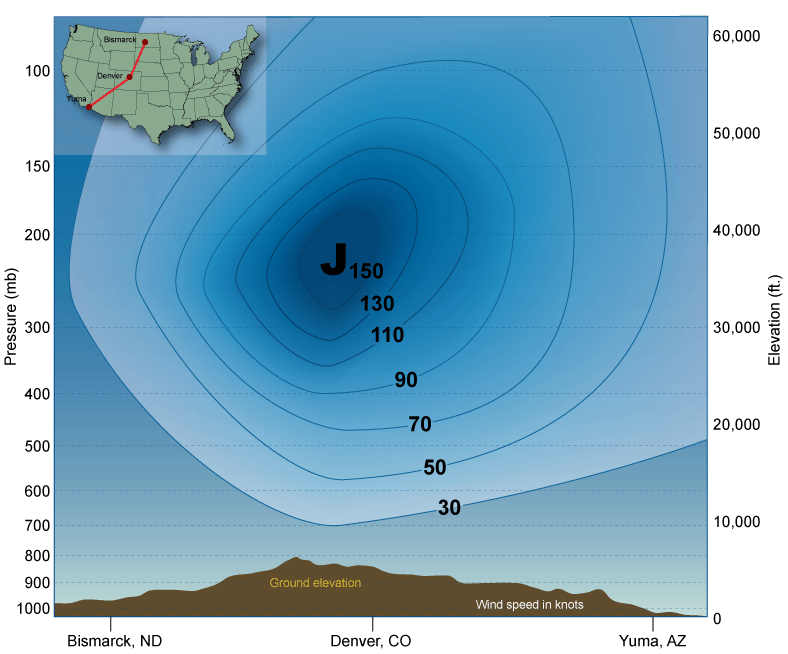Jet streams are relatively narrow bands of strong wind in the upper levels of the atmosphere, typically occurring around 30,000 feet (9,100 meters) in elevation.
Within jet streams, the winds blow from west to east, but the band often shifts north and south because jet streams follow the boundaries between hot and cold air.
Since these hot and cold air boundaries are most pronounced in winter, jet streams are the strongest during both the northern and southern hemisphere winters.
Why do the jet stream winds blow from west to east? Recall from the previous section what the global wind patterns would be like if the Earth was not rotating – the warm air rising at the equator would move directly toward both poles.)
We saw that the Earth's rotation divided this circulation into three cells, and it is responsible for the existence of the jet stream as well.
The rotational speed of the Earth’s surface, and thus the air above it, is relative to its latitude. Since the entire Earth makes one rotation in 24 hours, locations along the longer latitudes are rotating at a faster speed than the shorter ones because they are traveling more distance in the same amount of time. Therefore, the Earth’s rotational speed is fastest at its widest point, the equator. As a result, air moving away from the equator does not move directly north and south because it retains this rotational momentum, causing it to rotate faster than the surface below as it moves toward the poles.
Why the jet stream moves from west to east

Based upon the Earth's circumference at different latitudes, the velocity at which we at the surface move east in a 24-hour rotation decreases from over 1,000 mph (1,600 km/h) at the equator to zero at the poles. Someone standing on a pole is not moving east at all, just slowly spinning.
For air moving toward the poles, the Earth's rotational velocity decreases beneath it, but the air itself retains its eastward momentum. This results in wind that moves faster than the Earth rotates. Therefore, as air moves towards the poles, it also moves from west to east relative to the surface. This is the Coriolis effect.
Why the jet stream moves from west to east

Based upon the Earth's circumference at different latitudes, the velocity at which we at the surface move east in a 24-hour rotation decreases from over 1,000 mph (1,600 km/h) at the equator to zero at the poles. Someone standing on a pole is not moving east at all, just slowly spinning.
For air moving toward the poles, the Earth's rotational velocity decreases beneath it, but the air itself retains its eastward momentum. This results in wind that moves faster than the Earth rotates. Therefore, as air moves towards the poles, it also moves from west to east relative to the surface. This is the Coriolis effect.
Why the jet stream moves from west to east

Based upon the Earth's circumference at different latitudes, the velocity at which we at the surface move east in a 24-hour rotation decreases from over 1,000 mph (1,600 km/h) at the equator to zero at the poles. Someone standing on a pole is not moving east at all, just slowly spinning.
For air moving toward the poles, the Earth's rotational velocity decreases beneath it, but the air itself retains its eastward momentum. This results in wind that moves faster than the Earth rotates. Therefore, as air moves towards the poles, it also moves from west to east relative to the surface. This is the Coriolis effect.

The momentum the air has as it travels around the Earth is conserved, which means that as the air over the equator starts moving toward one of the poles, it keeps its eastward motion constant. The Earth below the air, however, moves slower toward the poles.
The result is that the farther the air moves from the equator, the faster and faster east it moves relative to the Earth's surface below.
In addition, with the three-cell circulations mentioned previously, the regions around 30° N/S and 50°-60° N/S are areas where changes in temperature at any one point are the greatest.
As the difference in temperature increases between the two locations, the strength of the wind increases. Therefore, the regions around 30° N/S and 50°-60° N/S are also regions where the wind in the upper atmosphere is the strongest.
There are several different jet streams, or jets, around the globe. The polar jet is located between the 50°-60° latitude lines in both the northern and southern hemispheres. The subtropical jet is located around the 30° latitude line. Jet streams vary in height of four to eight miles and can reach speeds of more than 275 mph (239 kts / 442 km/h).

The actual appearance of jet streams result from complex interaction between many variables, such as the locations of high and low pressure systems, warm and cold air, and seasonal changes. They meander around the globe, dipping and rising in altitude/latitude, splitting at times and forming eddies, and even disappearing altogether to reappear somewhere else.
Jet streams also "follow the Sun" – as the Sun's elevation increases each day in the spring, the average latitude of the jet stream shifts poleward. By summer in the Northern Hemisphere, the polar jet is typically found near the U.S. Canadian border. As Autumn approaches and the Sun's elevation decreases, the jet stream's average latitude moves toward the equator.

Jet streams are often depicted on weather maps by a line indicating the location of the strongest wind. However, jet streams are wider and not as distinct as a single line; they are regions where the wind speed increases toward a central core of greatest strength.
One way of visualizing this is to consider a river. The river's current is generally the strongest in the center, with strength decreasing toward the river's bank. For this reason, it is said that jet streams are "rivers of air".


